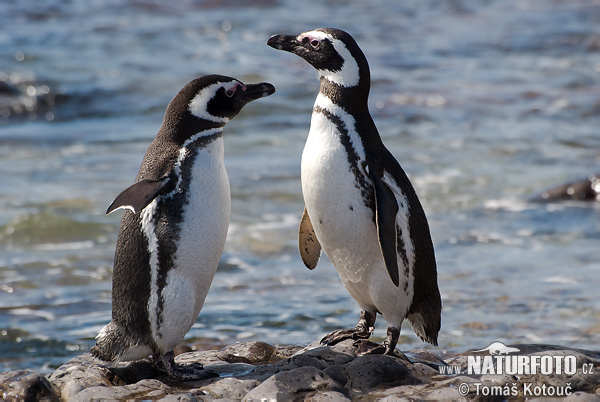
Spheniscus magellanicus
TAXONOMY
Aptenodytes magellanicus J. R. Forster, 1781, Strait of Magellan.
OTHER COMMON NAMES
French: Manchot de Magellan; German: Magellanpinguin;
Spanish: Pingьino de Magallanes.
PHYSICAL CHARACTERISTICS
28 in (71 cm); female weight 5.9–9.0 lb (2.7–4.1 kg), male
6.4–10.6 lb (2.9–4.8 kg). Boldly striped penguin with two black
bands across chest. Sexes similar but female smaller than male.
Cheeks and cap brownish black, divided by wide white ring.
Black back and white underparts lightly splotched with black.
Stubby black bill with gray band near tip. Eyes are brown. Feet
are pink blotched with black. Juveniles smaller than adults and
breast bands are not distinct.
DISTRIBUTION
Breeds in coastal areas and on offshore islands along the southern
part of South America, occasionally in southern coastal
Australia and New Zealand. Breeding
DISTRIBUTION
seems to be
moving northward. Migratory outside of breeding season; birds
from colonies at the tip of south America may travel as far
north as Peru and southern Brazil.
HABITAT
Breeds on bare or vegetated islands, in flat areas and on cliff
faces. Colonies located in areas where offshore winds cause upwelling
of deep, cold, nutrient-rich waters so that primary productivity
is high. Birds have best nesting success in protected
sites under bushes or other vegetation. Feed inshore during
breeding season and in pelagic waters during migration.
BEHAVIOR
Foraging birds may be seen porpoising in long lines, one after
the other. Breed in large colonies; often return to the same
nest site from year to year. Voice described as a mournful,
donkey-like braying; often call in chorus at night.
FEEDING ECOLOGY AND DIET
Eat mostly small, schooling fish such as anchovies, sardines,
and sprats but diet varies depending on prey availability. Most
dives descend 66–164 ft (20–50 m). Underwater swimming
speed measured at about 4.7 mi/hr (7.6 km/hr).
REPRODUCTIVE BIOLOGY
Where soil allows digging, they nest in burrows; otherwise
they build nests on the ground. Both members of pair build
nest. Two-egg clutch is laid and eggs are of similar size. Parents
share incubation, brooding, and guarding duties. Chick
hatched from second-laid egg less likely to survive to fledging.
Chicks independent at 60–70 days.
CONSERVATION STATUS
Listed as Near Threatened. A 1994 study estimated that oil
pollution kills 40,000 penguins a year on the southern coast of
Argentina.
SIGNIFICANCE TO HUMANS
In the past, native peoples killed penguins for meat and for
their skins. Today, Magellanic penguin rookeries at Punta
Tombo in Argentina are a major ecotourism destination, attracting
50,000 visitors a year.
Photo Gallery of - Magellanic penguin




 Animalia Life
Animalia Life